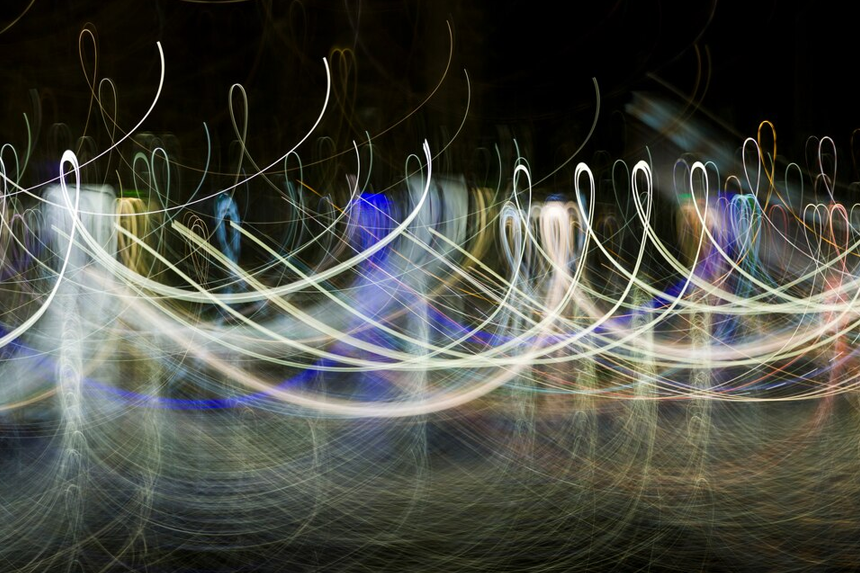If you have ever written your name in the air with a sparkler on a bonfire night, you have experimented with light painting. Enthralled by the “strings of light floating in mid-air,” Scottish photographer David Gilliver felt driven to document this magical phenomenon.
Reflecting on his first curiosity about the art form, he says, “I thought it was like sorcery; it’s like magic.” Mr. Gilliver has led the way in light painting techniques for the past 15 years. His artistic commitment has resulted in one of his pieces, Where Rainbows Sleep, being shortlisted in the recently created category of best low-light shot for the British Photography Awards this year.
How Does David Gilliver Create His Light Paintings?
Picture this: Clad in black and carrying a “lightsaber,” Mr. Gilliver stands in a pitch-black fishing boat house. This is the start of his creative process, not a scene from Star Wars. Mr. Gilliver channels one of the most famous villains in movies to fit the low-light setting. Maintaining the shutter open for times ranging from 30 seconds to 20 minutes, he says, “I’m like Darth Vader, but instead of ‘the Force,’ I use a long exposure photography technique.”
Noctourism: A Rising Trend in 2025’s Travel Adventures
Secured on a tripod, his camera is deliberately positioned at the other end of the room to prevent any blurring even the smallest movement could produce. He gently swooshes his lightsaber as he approaches the camera, then vanishes down a trapdoor. His careful exposure time lets him manually set off a flash gun, lighting the boat hut’s surroundings.
“Simple is often best,” Mr. Gilliver says as he talks about generating his light waves. He does, however, flourish in experimenting. In one of his arresting photographs, he creates an illusion of several floating butterflies using battery-operated butterfly keychains. Attached to the old Callanish stones on the Isle of Lewis, another fascinating work shows an eerie orb made by swinging a light at the end of a string like a lasso during prolonged exposure.
What Challenges Did David Gilliver Face on His Path to Creativity?
Having graduated from Glasgow School of Art, the 45-year-old artist has always had a creative bent. Still, his road to becoming a full-time artist was difficult. He started his career in finance in the Channel Islands fourteen years ago. During this period, he became “utterly obsessed” with light painting, working to replicate the “magical” Guernsey landscapes by night.
Returning to Scotland in 2015, he discovered inspiration in the “dramatic” and “iconic” backgrounds of his native country, restoring his creative energy. Mr. Gilliver decided boldly in 2018 to quit his 9-to-5 employment and explore his love of photography.
How Does David Gilliver Share His Passion for Photography?
As he started posting his light paintings online, he became aware of increasing curiosity among viewers. “Most people would ask me how I did it,” he says, pointing out that many photographers expressed a wish to travel with him through his artistic process. Currently living in Gartcosh, North Lanarkshire, Mr. Gilliver travels the country teaching eager students his light painting methods.
“People often think the technique is difficult to grasp, but once they start to experiment and play with light, it is really very accessible,” he says. For him, instruction has had a transforming effect. One of the many pleasures of teaching, he says, is “watching their eyes light up as they start to learn the creative possibilities of this amazing art form.”
What is the Macro World of Photography Like for David Gilliver?
Apart from light painting, Mr. Gilliver has a remarkable portfolio of macro photography, which enables very close-ups of insects, flowers, and other things. From famous movie reenactments to tackling more somber subjects, he imaginatively combines little figures into imagined situations. This year’s macro category shortlist also includes his rendition of Leonardo DiCaprio and Kate Winslet’s well-known “I’m flying” sequence from Titanic. The picture shows little Jack and Rose atop an electric iron.
Mr Gilliver is not new to the British Photography Awards; he transformed a face mask into a swimming pool to reflect on the COVID-19 epidemic and won the best macro shot category in 2022. “Key is delivering a serious message without trivializing what you’re talking about,” he says.
How Does David Gilliver Balance His Artistic Forms?
Regarding his creative pursuits, Mr. Gilliver struggles to pick a preferred type of photography. “Light painting feels more like an experience; macro photography exercises my imagination,” he says. He thinks that the “incredible process reigns supreme” in light painting because of its “experiential” quality.
This year, he has been shortlisted for three British Photography Awards: commercial photography, low-light photography, and macro photography—including best macro. As the awards ceremony draws near, Mr. Gilliver is still evidence of the artistic opportunities found at the junction of light, imagination, and photography.






